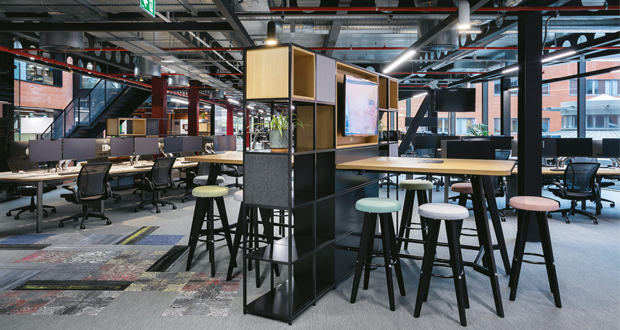CHOICE
Flexible office furniture can help make even the smallest of workplaces meet multiple different needs and styles. It can promote choice, aid wellbeing (physical and mental) and support employees with an increasingly task-orientated approach to work. With that in mind, here are four flexible office furniture considerations for the post-pandemic workplace:
Sit-stand: Designed in response to a need to make office workers less sedentary, sit stand desks help employees to move more and promote greater choice. While the widespread adoption of these desks is still in the early stages (most employers apportion 10-20 per cent of their desking to sit stand), there are some organisations who have been quick to champion sit-stand flexibility. Interactive entertainment company King is one such example. We designed a mobile sit-stand desk solution so their team could manage their personal comfort and reconfigure furniture easily as their needs changed. These desks changed their collaborative dynamic and made it possible for mini-teams to coalesce easily – whether that’s moving desks into mini huddles or simply rotating them 90 degrees to face their colleagues.
Space-defining structures: Flexible furniture can help to zone open-plan spaces. Our recent development of TT, a modular grid-based shelving system and Scrumwall are perfect examples. Both are space-defining structures with a high degree of functionality and user engagement, thanks to a wide variety of add-ons such as standing tables, lockers, write-on surfaces, and integrated AV. Furniture of this ilk enables numerous different work settings to radiate from one central spine and provides a cost-effective and flexible way to create distinct zones within large open floor plates. Other furniture in this category includes high-backed seating booths, storage systems and self-contained meeting pods – all of which create spaces within spaces and boast multiple uses.
Alternative meeting spaces: Not all meetings are face-to-face. Not all meetings need to be held in private meeting rooms either. In fact, impromptu collaboration and quick team meetings can be best supported with more informal and flexible spaces. This might be achieved with den-style furniture – typically semi-enclosed soft seating which offers acoustic privacy and comfort in equal measure – or through touch-down spaces. More collaborative team gatherings may require a meeting room, but kitchen table project setting or informal company presentation areas provide other useful options, while conference calls or video meetings are best suited to individual phone and AV booths, where acoustics and privacy have been fully considered.
Easy to move: Whether it’s being able to quickly pull up extra seating to a collaboration table, moving desks into a new configuration or wheeling write-on surfaces into a meeting area – the modern office needs furniture that is quick, easy and safe for people to move as and when they require. This doesn’t have to mean everything on castors either, as designers and manufacturers have engineering solutions that are light and simple to move.
Flexibility is at the very core of the hybrid working concept. It affords people greater choice and autonomy, which typically turns into greater wellbeing, productivity, and loyalty too. For FMs striving to create ergonomic, choice-led, agile and relevant workplaces, flexible office furniture creates a valuable win-win.






